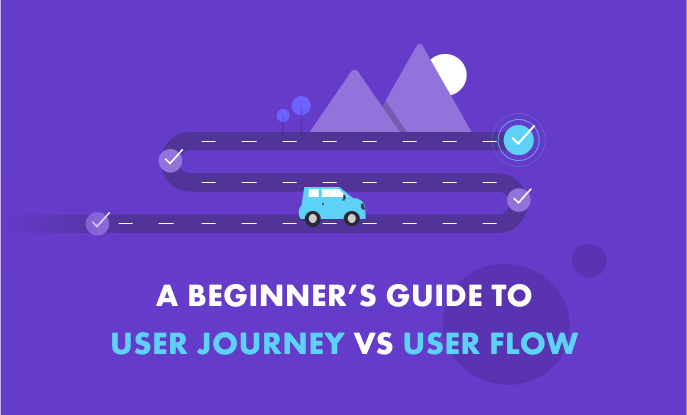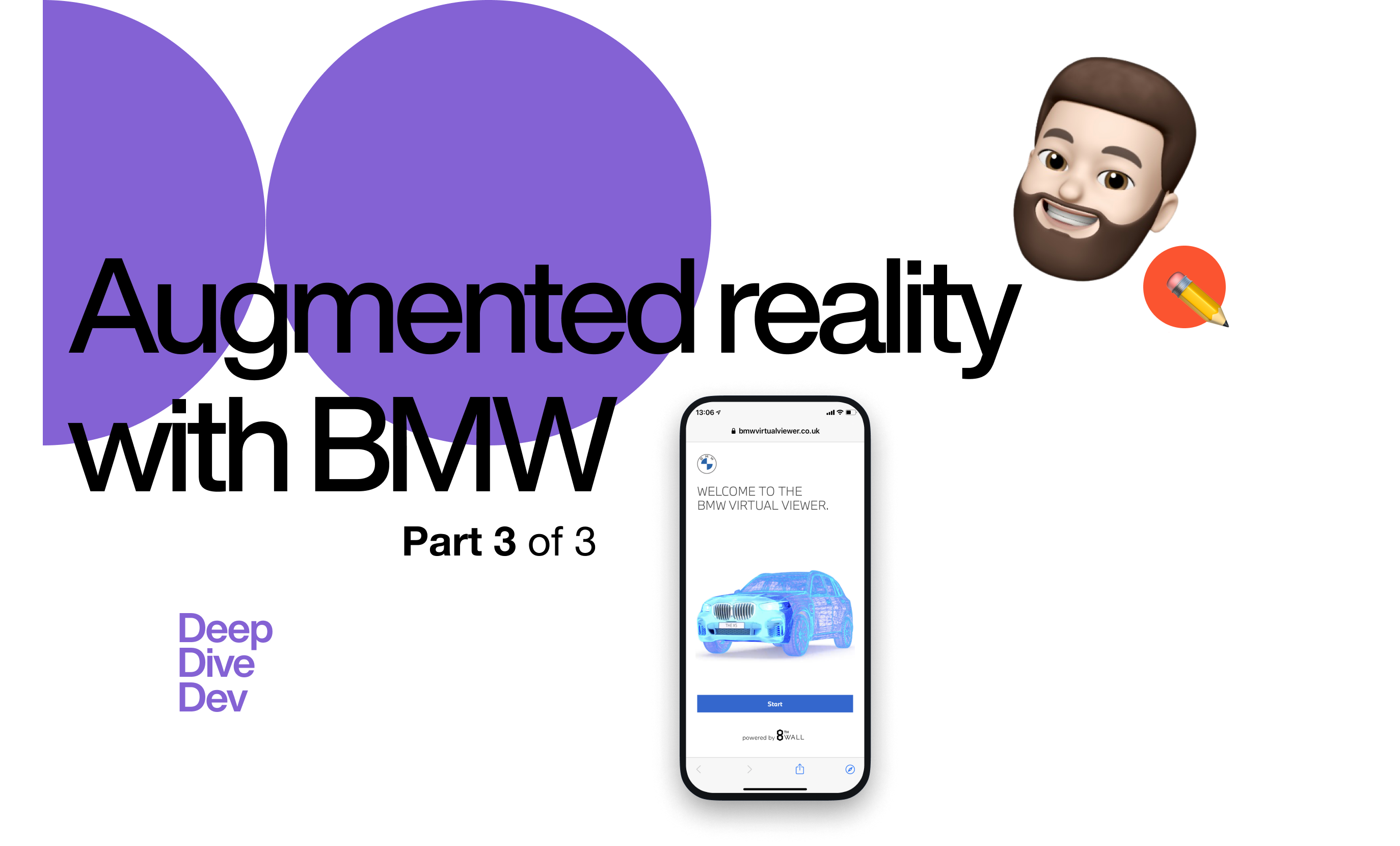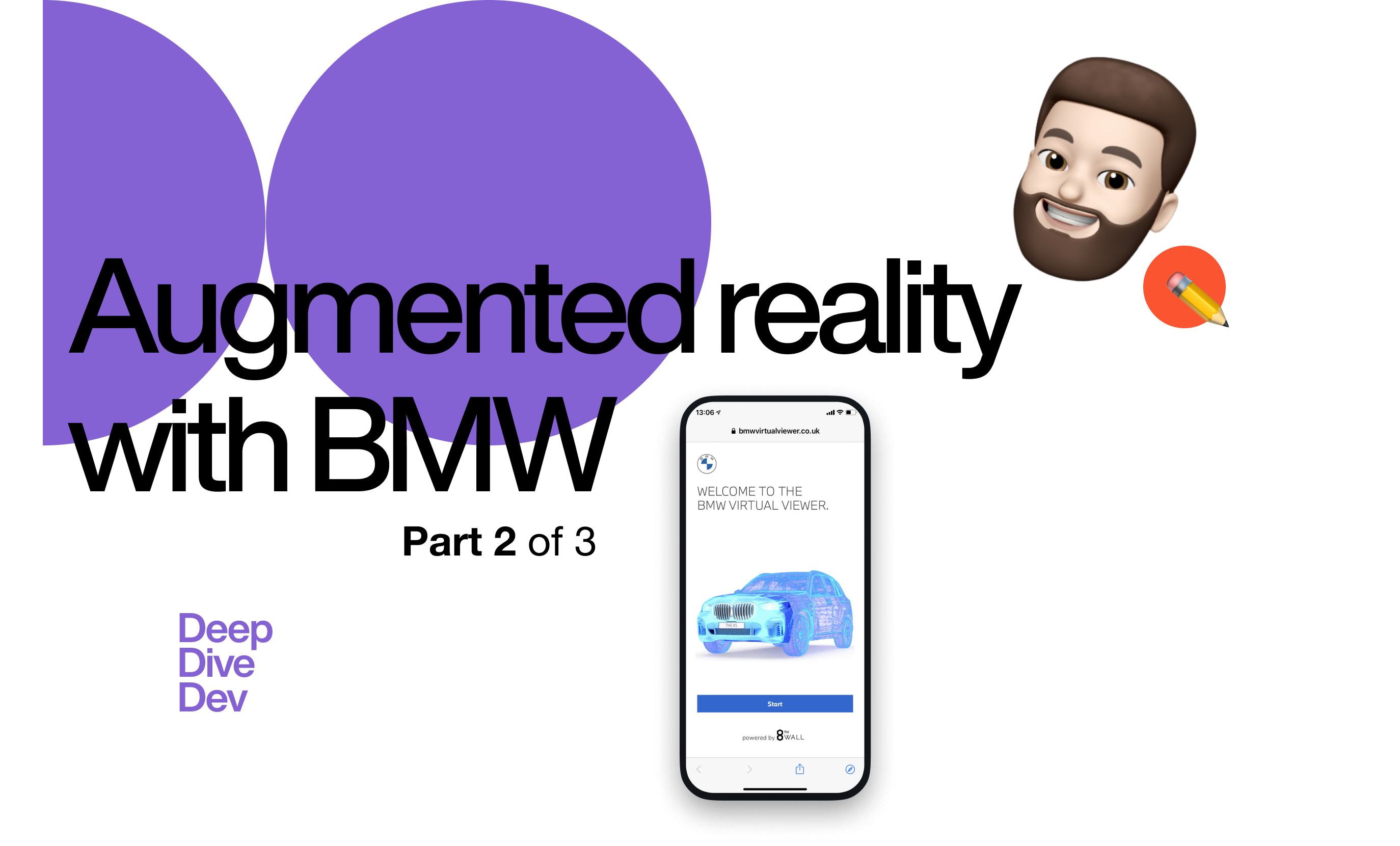Both terms – user journey vs user flow – are associated with describing the story of the product from the user’s point of view. They contribute greatly in improving the product experience.
More often than not, both these terms are used interchangeably. So, are these the same? Inherently, they are similar in a lot of ways, but they also have their differences.
In short, the user journey offers a high-level overview on the user’s interaction with a product, while the user flow describes how it is actually done in detail. But they focus on different aspects of the design. So, what makes them so different yet alike?
This is what this article is all about.
Let’s check out.
What Is A User Journey?
The user journey is all about creating a visual path for the user’s trip during using a product.
However, the user journey isn’t just about the steps involved in using the product but also considers the feelings, difficulties, and wins of the user.
Essentially, it models the relationship between the user and the product over time and in various channels.
Channels are the communication methods or the ways through which the product reaches the user. A channel could be a physical store where the user buys the product or a website where they can place online orders.
Investigating channels can be handy when looking for gaps in user experience.
For example, the user could have a preferable channel, and be completely averse to other platforms. They could love the shopping experience of the retail store, and find the product delivery or quality completely subpar in the online channel. Understanding these can uncover what creates positive user experience and what needs to be improved.
The user journey considers the entire path the user takes while interacting with your solution. The journey starts from the point when the customer realizes the problem or need and first interacts with your company, all the way until they leave satisfied (hopefully).
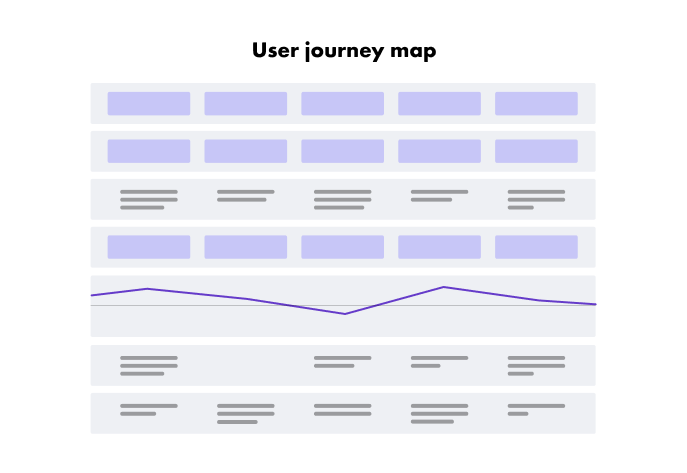
For example, when using an application, a customer journey would cover all the stages of user interaction with the product:
- Awareness: realizing the problem they have
- Search: looking for an application to solve their problem
- Download: downloading the app
- Installation: registering and onboarding to the application,
- Use: using the application
- Support: getting help, when stuck with the product
- Review: (if) when they write feedback about the product
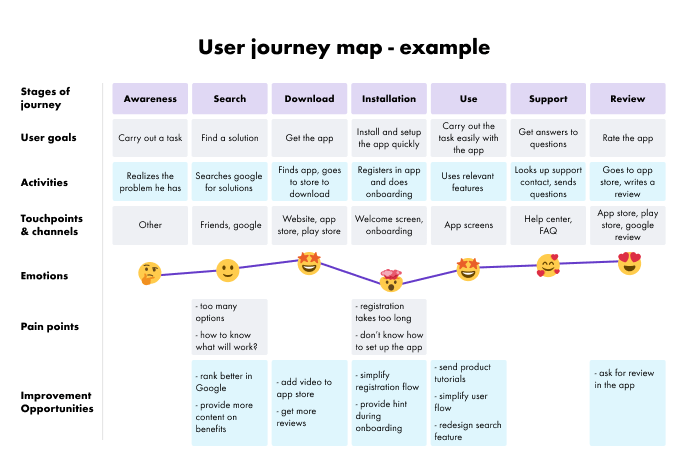
Next to the key steps, it displays the customer’s emotions at each particular stage and what exactly triggered them. It keeps track of what the user wants and how they react at each stage when experiencing the product.
The user journey could be as simple as a user landing on the signup page for an app that is used on the browser, then going through tutorials and using the software.
What Role Does A User Journey Have?
Creating a user journey helps to create a streamlined vision for the product.
With this, product teams know exactly how the interaction between the product and user works. It keeps the designers in the same boat as their customers and helps them explore the difficulties that they are facing and the features that they like.
Even people who are in no way related to a particular industry can still understand the user journey, which makes it a vital tool for sharing ideas with all the stakeholders in the process.
How Does The User Journey Benefit The Design Process?
The most important benefit of the user journey is understanding the emotions and triggers that users experience while they are using the product.
The user journey detaches itself from the design process and observes how it impacts the user throughout the whole process by understanding their motivations. It interprets the decisions they are making in the process and how they feel in the end.
With the help of the user journey, you can investigate every side of the solution, and provide key pointers on how to design and improve the product. It is essential for creating a minimum viable product and it shows you the scope that your solutions will have in terms of usefulness and popularity.
What Is A User Flow?
User flow is the path that a user takes when they are using a product and want to finish a particular task.
The user flow includes the steps the users take from the moment they enter the website or application to the final move, such as buying a product, clicking an affiliate link, or watching a video. In the case of landing pages, the most important flows are about how the conversion happens.
Determining user flow plays an essential role in designing and developing intuitive products and web pages.
Typically we split up the UX into several user flows, not just one that embraces all the features of a product. It would be too complex to use. So, in most cases, user flows describe certain features — some of which are only shown to a user when they are already on the website for a while.
The user flow does not consider the emotions of the user at any stage, as the user journey does. Instead, it zooms in on the technical aspects.
A user flow is required to make sure that users have everything they need to accomplish an action, including the screens they see, the actions that are offered, the information that you show on each page and the button users need to push to proceed to the next stage.
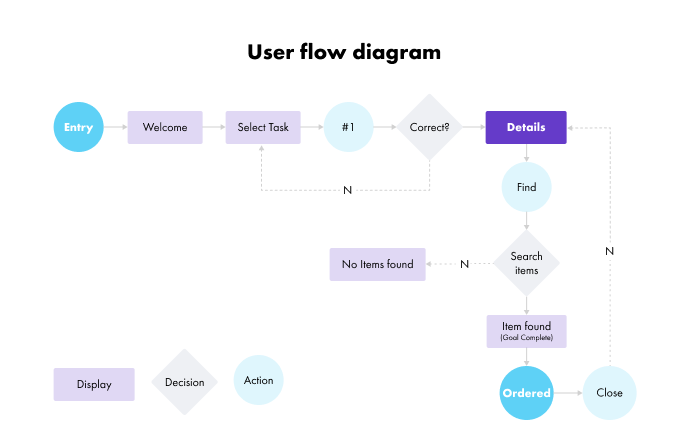
What Role Does User Flow Have?
User flow is a great tool for segmenting the user experience and defining concrete actions that can be implemented in the design. It talks about what a user sees on the screen and how they interact with the screen to move forward.
As is evident, user flow is crucial for the development phase, as developers use the user flow to translate the designs into physical features. Every user flow design has a name and a description of what each of the steps is and what it is accomplishing.
How Does A User Flow Benefit The Design Process?
As a visual representation of the features user flow helps you understand how users navigate in the product.
This will help you and your designers to clearly visualize what a user will see at each step as they go through the product. Spotting missing information, illogical steps or confusing text gets really easy with user flows.
Example of User Journey vs. User Flow
Let’s take our usual electric vehicle renting application as an example.
If you are a new reader, imagine an application where you can list and rent all the electric vehicle options in big cities.
The users’ objective is to choose and successfully rent an electric vehicle.
A user flow would usually start with the user’s home screen, then the applications launch screen, search and filter screen and maybe a map screen asking for an address of the destination of the nearest renting place. There might be an extra screen that confirms the completion of the rent.
A user journey, however, would consider the user’s motivation to use the application. This is when a scenario would be helpful. A sample scenario could be: the user is looking for an environmentally friendly vehicle to use when sightseeing in the city.
The first touchpoint of the journey could be him planning what he wants to see and realizing that tour would be difficult to cover by walking.
The next touchpoint could be the user researching options, how people usually get around in town.
When designing the user experience, we consider these touchpoints so that we can imagine what state of mind the user might be in.
Are they happy or sad? Excited or maybe frustrated?
His next steps might then be to open the electric vehicle renting app. This is where the user journey vs user flow usually overlap. The following steps can seem similar, but the purpose of each tool is different.
The user flow would be more specific about the path a user takes during the task of renting an electric vehicle. The user journey, on the other hand, focuses on the user’s state of mind, mapping if they are enjoying the process or experiencing discomfort during it.
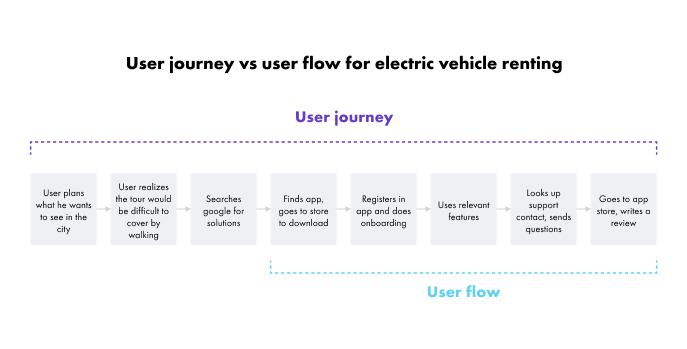
The Differences Between a User Journey vs. User Flow
Experience focus vs. use focus
User journey focuses on the design of the complete process from beginning to end, whereas user flow is concerned with the details of each step down to the actual detail of the screens.
Journey tracks the emotional path of the user
The user journey tracks how users feel about the product. Do they feel motivated enough to continue to buy the product? User flow will be concerned with mapping out all the routes through which this goal can be achieved.
The user journey is the guiding process, user flow is the tool
In a user interface, the user journey works as the guide that directs users to the goal – e.g. the user takes this path to buy the product.
The user flow is design-oriented and lists the tasks needed to achieve the goal – the user needs to click on the buy button to access the cart, then click payment to complete payment.
The Similarities Between a User Journey and User Flow
Here’s what user journey and user flow have in common:
- Both focus on the user
- Both define how a product and users interact
- Both outline the behavior of a user
- Both outline the process of delivering a good user experience
- Both help determine the possible actions of the user
- Both serve as reference points when designing the interaction between product and user
When to Use A User Journey Vs. User Flow?
When to use user journeys?
User journeys work great in getting on the same page about the entire user experience for various stakeholders with technical, and non-technical backgrounds alike. This happens usually during product review sessions when the product team wants to understand how users experience the product.
Another use case is after they launched a product, collected feedback from the users and want to prioritize feature requests. The user journeys help teams arrange features based on the user’s needs.
When to use a user flow?
User flows guide designers and developers to build an intuitive user interface for a product.
It is also great for evaluating the shortcomings of the interface that already exists.
Wrap Up
As you can see, user journeys outline the overall user actions and interactions with a product, while user flows guide the technicalities in making the actions a reality.
Both user flow and user journey share the path of the user and work together on the design of the interface by determining the user requirements.
They help understand what could be improved in application design, by helping companies gather data on the decisions made by the users to accomplish a task. They are driven by user persona and thus outline the possible actions of the user.
They help create a flowchart of the entire user journey in minute detail, from physical actions to emotions guiding those actions, and they can help predict future actions of the user. They serve as guides that companies can use to design the best possible application possible to meet user goals.
Now it’s your turn
Now we would like to hear from you:
What is the main difference between user journeys and user flows in your opinion?
Will you design a user journey for your product?
Let us know in the comment section below.


